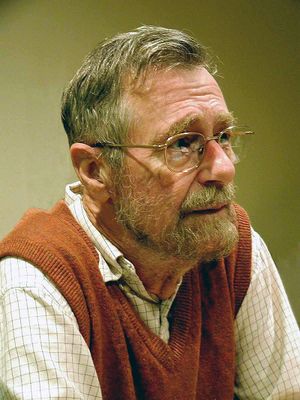إدسخر دكسترا
إدسخر ويبى ديكسترا (بالهولندية: Edsger Wybe Dijkstra) عالم حاسوب هولندي. حاز في 1972 على جائزة تورينغ لمساهماته الأساسية في تطوير لغات البرمجة.
. . . . . . . . . . . . . . . . . . . . . . . . . . . . . . . . . . . . . . . . . . . . . . . . . . . . . . . . . . . . . . . . . . . . . . . . . . . . . . . . . . . . . . . . . . . . . . . . . . . . . . . . . . . . . . . . . . . . . . . . . . . . . . . . . . . . . . . . . . . . . . . . . . . . . . . . . . . . . . . . . . . . . . . .
حياته
ولد ديكسرا بروتردام في هولندا، لأب كيميائي وأم رياضياتية.
تعلم الرياضيات والفيزياء النظرية في جامعة ليدن. عمل في السنوات 1952-1962 كمبرمج، أكمل خلالها الدكتوراه في علم الحاسوب بجامعة أمستردام. أطروحة الدكتوراة، والتي سلمها في عام 1959، حملت عنوان Communication with an Automatic Computer، واستندت أيضا على خبرته كمبرمج.
في السنوات 1962-1984 كان بروفيسوراً للرياضيات في جامعة آيندهوفن، وفي السنوات 1973-1984 كان باحثاً في شكرة بوروز. وفي السنوات 1984-1999 كان بروفيسوراً لعلم الحاسوب في جامعة تكساس، أوستن.
حصل ديكسرا على جائزة تورينغ لسنة 1972.
أطلق اسمه على جائزة ديكسترا لرابطة مكائن الحوسبة. الجائزة تمنح كل سنة للمقال الذي كان له أكبر تأثير (لمدة عشر سنوات على الأقل) على مجال الحوسبة الموزعة. ديكسترا كان الفائز الأول بالجائزة (قبل أن اطلق عليها اسمه).
بعض من كتبه
- Structured programming (with O.J. Dahl and C.A.R. Hoare), Academic Press, 1972
- A Discipline of Programming, Prentice-Hall, 1976
- Selected Writings on Computing: A Personal Perspective, Springer Verlag, 1982.
راجع أيضا
- ^ Marateck, Samuel L. (1977). FORTRAN (Academic Press), p. 488
- ^ Courtois, Pierre-Jacques (2008). Justifying the Dependability of Computer-based Systems: With Applications in Nuclear Engineering (Springer), p. 112
- ^ Denning, Peter J.; Martell, Craig H. (2015). Great Principles of Computing (MIT Press), p. 157
- ^ Birrell, N. D.; Ould, M. A. (1985). A Practical Handbook for Software Development (Cambridge University Press), p.181
- ^ Haigh, Thomas (2010)
- ^ Albin, Stephen T. (2003). The Art of Software Architecture: Design Methods and Techniques (Wiley Publishing, Inc.), p. 3
- ^ Hoare, C. A. R. (12 October 2010). "The 2010 Edsger W. Dijkstra Memorial Lecture: What Can We Learn from Edsger W. Dijkstra?". Department of Computer Science, The University of Texas at Austin. Retrieved 12 August 2015.
- ^ Ryder, Barbara G.; Soffa, Mary Lou; Burnett, Margaret (2005). Impact of Software Engineering Research on Modern Programming Languages. ACM Transactions on Software Engineering and Methodology, Vol. 14, No. 4, October 2005, p. 431-477. "Of great influence to Pascal was Structured Programming, put forth by E. W. Dijkstra. This method of proceeding in a design would obliviously be greatly encouraged by the use of a Structured Language, a language with a set of constructs that could freely be combined and nested. The textual structure of a program should directly reflect its flow of control."
- ^ Wirth, Niklaus (2008). A Brief History of Software Engineering. IEEE Annals of the History of Computing, vol.30, no. 3, July–September 2008, pp. 32–39. "In 1965 Dijkstra wrote his famous Notes on Structured Programming and declared programming as a discipline in contrast to a craft. Also in 1965 Hoare published an important paper about data structuring. These ideas had a profound influence on new programming language, in particular Pascal. Languages are the vehicles in which these ideas were to be expressed. Structured programming became supported by a structured programming language."
- ^ In his 2004 memoir, "A Programmer's Story: The Life of a Computer Pioneer", Brinch Hansen wrote that he used "Cooperating Sequential Processes" to guide his work implementing multiprogramming on the RC 4000, and described it saying, "One of the great works in computer programming, this masterpiece laid the conceptual foundation for concurrent programming."
- ^ As Lamport (2002) wrote, "Edsger W. Dijkstra started the field of concurrent and distributed algorithms with his 1965 CACM paper "Solution of a Problem in Concurrent Programming Control", in which he first stated and solved the mutual exclusion problem. That paper is probably why PODC exists; it certainly inspired most of my work."
- ^ خطأ استشهاد: وسم
<ref>غير صحيح؛ لا نص تم توفيره للمراجع المسماةLamport (2015) - ^ Lo Russo, Graziano (1997). "An Interview with A. Stepanov (Edizioni Infomedia srl.)". STLport. Retrieved 30 August 2015.
Alexander Stepanov: "...I also discovered books of two great computer scientists from whose work I learned the scientific foundation of my trade: Donald Knuth and Edsger Dijkstra. Knuth taught me the answers. Dijkstra taught me the questions. Time and time again I come back to their works for new insights."
{{cite web}}: CS1 maint: numeric names: authors list (link)
